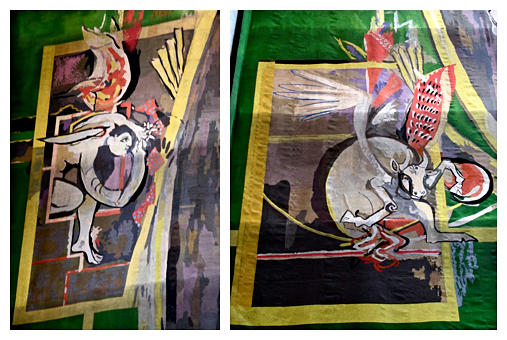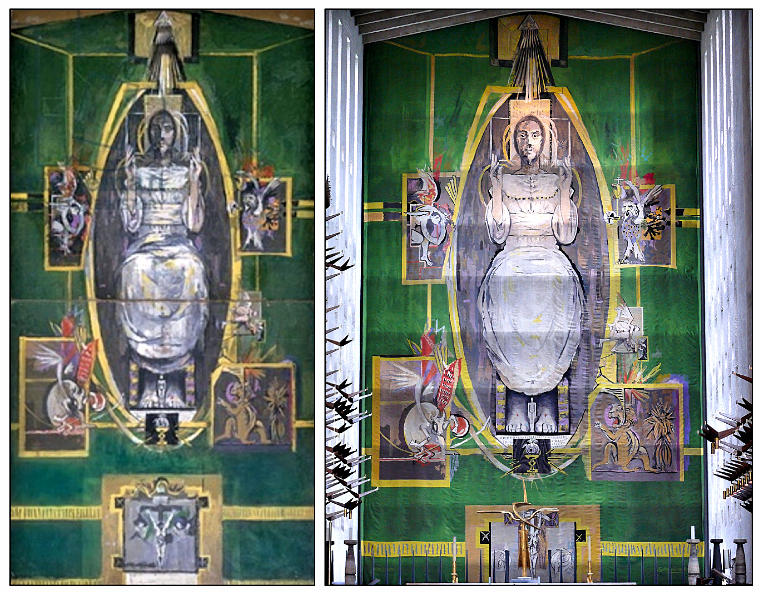|
Index...
|
 he tapestry is from the bible which says; "In the centre is seated Christ. Round about the throne, were four beasts full of eyes before and behind. And the first beast was like a lion, and the second beast was like a calf, and the third beast had a face as a man, and the fourth beast was like a flying eagle. And the four beasts had each of them six wings about him; and they were full of eyes within."
he tapestry is from the bible which says; "In the centre is seated Christ. Round about the throne, were four beasts full of eyes before and behind. And the first beast was like a lion, and the second beast was like a calf, and the third beast had a face as a man, and the fourth beast was like a flying eagle. And the four beasts had each of them six wings about him; and they were full of eyes within."
Looking at the Tapestry, I have always wondered what type of story Dan Brown could write about the mysteries of Graham Sutherland's Coventry Cathedral Tapestry. In Dan Brown's The Da Vinci Code he looks very hard into the symbolism of the Last Supper by Leonardo da Vinci, one of the most widely read novels of all time. I am not saying that Coventry Cathedral's Tapestry has a historic secret to hide, but more a case of "what was Graham trying to say to us in the future?" I have always felt that the tapestry is more of a 'mood board' of the art and artists of the 1950s.


The subject is a common one. 'Christ in Glory' has been done very many times throughout history; the last judgement, and the resurrection of Christ, from the last book in the bible. Graham was working within the very limited confines of the brief - it has to have Christ seated, with representations of St. Matthew, St. Mark, St. Luke and St. John surrounding him. He also added to this an image of St. Michael, after the Cathedral. What is interesting about this image is the fact that it's taken from photographs by Eadweard Muybridge. Francis Bacon, a good friend of Graham's, was using these images in his paintings, so was he giving a nod to his friend in this '1950s Mood Board'?

Graham Sutherland was a skilled illustrator. He had taught art, etching, engraving and book illustration, and you can see that he can draw if you look at the face of Christ in the tapestry, but if you look at St. Matthew to the left, top of the tapestry, it's very Picasso like, and under that is the representation of St. Luke, the sacrificial bull - but this looks just like a painting of bull fighting scenes (note the blood and guts coming out of the bull) by Pablo Picasso, who we know was also a good friend of Graham's (see photo on the right of Graham Sutherland and what looks like John Hutton visiting Picasso at his studio). So, is Picasso also on the list of the '1950s Mood board'?

 he Crucified Christ at the bottom is very Graham Sutherland, very much like his Crucifixion that he did for St. Matthew's church, Northampton, which Basil Spence had seen and liked and which gave him the idea to ask Graham to do the tapestry. What is interesting is the comparison between the cartoon and the finished tapestry. If you look at them both, at first you think the finished tapestry is a good representation of the cartoon. To do this they photographed the cartoon and did large black and white prints which Graham Sutherland went over and gave fine tweaks to. He would also go to the weavers and do alterations to the design while they were weaving. Did he discretely alter the design without telling anyone? We know he visited Pinton Freres of Felletin, France, on nine occasions. Could it be because it would not be seen until the tapestry was unrolled, and then it would be too late to change?
he Crucified Christ at the bottom is very Graham Sutherland, very much like his Crucifixion that he did for St. Matthew's church, Northampton, which Basil Spence had seen and liked and which gave him the idea to ask Graham to do the tapestry. What is interesting is the comparison between the cartoon and the finished tapestry. If you look at them both, at first you think the finished tapestry is a good representation of the cartoon. To do this they photographed the cartoon and did large black and white prints which Graham Sutherland went over and gave fine tweaks to. He would also go to the weavers and do alterations to the design while they were weaving. Did he discretely alter the design without telling anyone? We know he visited Pinton Freres of Felletin, France, on nine occasions. Could it be because it would not be seen until the tapestry was unrolled, and then it would be too late to change?
Sutherland had focused his artwork on the inherent strangeness of natural forms, and abstracting them, sometimes giving his work a surrealist appearance; in 1936 he exhibited in the International Surrealist Exhibition in London. So he would have wanted to pay homage to the greatest surrealist, Salvador Dali. If you look at The Madonna of Port Lligat 1950 paintings (below) you will see a similar setting - note the cuffs and hands of the Madonna - but what is striking is the loaf in the centre of Christ. If you look at other paintings by Dali the main theme is eggs!

Artists love doing folds in cloth, it's one way of showing off, but Graham has taken out the folds on Christ's knees in the Tapestry. Why? Would Dan Brown make a link between the bombed old Cathedral, a symbol of Christ's suffering which we commemorate on Good Friday, and the new Cathedral, a symbol of resurrection and re-birth, which we commemorate on Easter Sunday and in which the egg plays a big part?

Graham Sutherland never attended the unveiling of the tapestry or the consecration of the Cathedral in 1962. Was it because he did not want the criticism, like he received when Winston Churchill mocked his portrait of him? Or did he know that a large egg in the middle of the picture would not go down very well?
Did anyone even notice? Or perhaps like in the tale of the Emperor's new clothes people only see what they want to see? What other symbols would Dan Brown see, what twists and turns, what tales could he make up? Who else is being represented, and which artist's style is the eagle and lion in? Can you see any clues? Is there a Stanley Spencer reference, or John Piper, Max Ernst, Elizabeth Frink or John Hutton?
I look forward to hearing your thoughts.
Paul Maddocks, 2023
Website by Rob Orland © 2002 to 2025